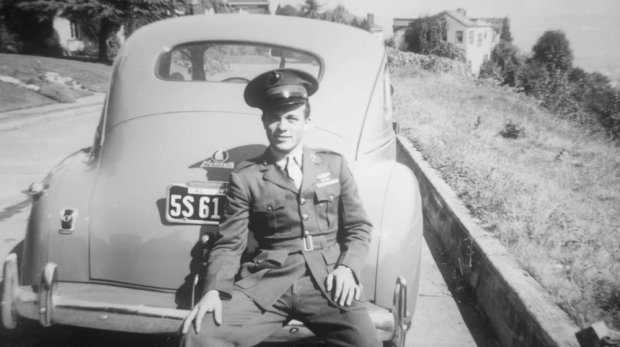Scotty and the Secret History of Hollywood
The way the very impressively spry nonagenarian Scotty Bowers tells it, it all really started when film star Walter Pidgeon pulled up in his ’46 Lincoln Continental to the Sunset Boulevard gas station where Scotty, recently mustered out of the Marines, was pumping gas. Observing the attendant’s comely appearance, the actor inquired about the possible availability of additional, more personal services. And whiz-bang, there followed Scotty’s first professional transaction with a celebrity trick.
Soon he was arranging for Pidgeon to enjoy the company of a number of his young, attractive male friends and acquaintances, which Scotty seemed to have in abundance. As he relates things in Matt Tyrnauer’s curious, enthusiastic documentary, Scotty and the Secret History of Hollywood, word of mouth spread the recommendations sub rosa and soon Scotty was accommodating customers and working boys in a trailer in back of the station and at a friend’s motel across the street. And his customer list included some pretty high-placed move-industry talent: actor Charles Laughton, A-list director George Cukor (A Star Is Born, My Fair Lady), Katharine Hepburn. (She wasn’t after boys.) Wait, wait, it gets better, or worse. The ambisexual Scotty says he helped out the Duke and Duchess of Windsor, who supposedly liked to watch threesomes perform.
Tyrnauer’s movie was inspired by a memoir of the same title Scotty wrote and published a few years ago. It’s a little hard to know how to take all this. On the one hand, it does have at least a modest, slightly musty element of delicious dish, for the limited audience remaining for old-Hollywood gossip. On the other, there is some room for doubt about some of these alleged confessions and revelations. There’s precious little corroboration for these stories (a complaint lodged against the book). Several talking-head worthies pay tribute to Scotty’s historical importance and generous spirit, including actor Stephen Fry and former Variety editor Peter Bart, but tributes like these aren’t really evidence.
It’s not a matter of doubting that there was a gay Hollywood underground, for there surely was, and it’s been examined before in more disinterested terms. Scotty comes across as a sort of combination Hollywood Madam and none-too innocent Zelig. His stories can engender some suspicion of varying degrees of exaggeration, as when he tells us of a poolside three-way involving him, Ava Gardner, and Lana Turner, at Frank Sinatra’s place yet. As if!
Tyrnauer’s movie really functions more effectively as a portrait of an amusing, genial, probably inventive survivor of a time when homosexuals feared discovery and police surveillance and occasional brutality, a time to which Scotty bears credible witness. He may be the social and generous guy portrayed here (he claims he wasn’t a pimp because he took no cut) and some portion of his story may be more or less true, but the movie doesn’t make much of a case. Scotty appears to be an affluent owner of several Hollywood-area homes—courtesy of a late lover—each of them packrat-stuffed with decades of accumulation, which makes the lack of documentation more curious.
Tyrnauer follows Scotty around LA and sometimes the film’s pace and interest flag. At times Scotty becomes slow and focused on extraneous material. Those with a durable nostalgia about the bygone era this man claims to have enlivened behind the scenes, this teller of tales tall or otherwise, may find this movie enjoyable. It will be at the Dipson Eastern Hills Cinema for five days only beginning this Friday.

